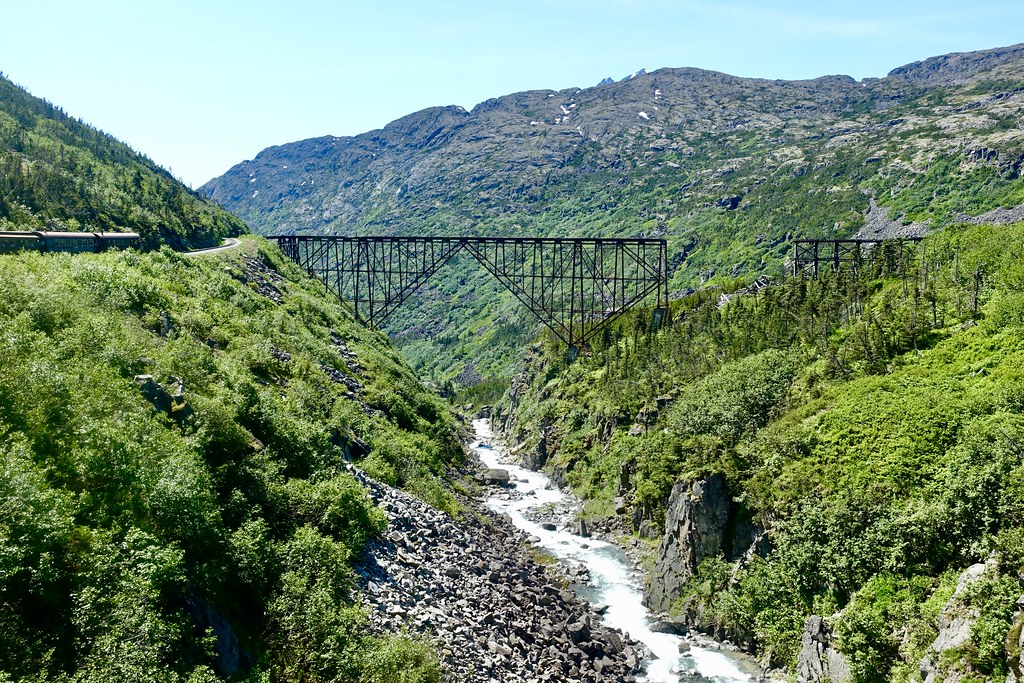
The White Pass & Yukon Route (WP&YR) train observation spot offers breathtaking views of the rugged landscapes along the historic narrow-gauge railway. Nestled in the scenic White Pass, it provides panoramic vistas of towering mountains, deep gorges, and lush forests, making it a must-visit for nature enthusiasts and history buffs alike.
Photos
Sign in to upload photos
No Photos Yet
Be the first to share photos of this location!
White Pass (WP&YR) – Skagway, Alaska, USA | Train Spotting Location
Trainspotting Experience
A typical visit centers on the sweeping curve just south of the summit, where the line emerges from the 873-foot Tunnel Mountain bore and heads toward the steel cantilever bridge at 2,865 feet above sea level. Trains approach at roughly 15–20 mph, allowing ample time to set up shots and listen to the characteristic chuff of EMD-powered diesel-electrics or the occasional steam excursion. Consists usually run with two locomotives on the point, 12–15 restored passenger coaches in tow, and a third unit pushing on the steepest stretches. The narrow 3-foot gauge and tight curvature bring the train close enough that wheel flange squeal and air-horn echoes become part of the mountain soundtrack. Expect wind gusts and shifting light; pack layers and a stable tripod.
Landscape, Setting & Local Atmosphere
White Pass straddles a windswept saddle between coastal rainforest and sub-arctic tundra. Stunted spruce and mountain heather cling to rocky outcrops, while cobalt tarns fill glacial bowls below the tracks. Even midsummer temperatures can hover in the 40s °F, and fast-moving clouds often trade sunshine for mist within minutes. The sweeping, treeless ridgeline grants uninterrupted sightlines for nearly a mile of track, punctuated by snow patches that linger well into July. The only ambient sounds are locomotive exhaust, distant waterfalls, and the whistle of high-altitude wind through telegraph poles—most vehicular traffic remains far below on the Klondike Highway.
Type & Frequency of Train Activity
WP&YR operates as a seasonal heritage passenger carrier rather than a freight railroad. From early May through late September, as many as 8–10 round trips run daily between Skagway and either White Pass summit or Bennett, B.C., timed to coincide with cruise-ship schedules in Skagway harbor. Train length averages 450–550 feet, hauled by rebuilt GE Shovelnose diesels (class DL-535E) or EMD GP-style units re-gauged for 3-foot track. Steam locomotive No. 73, a 2-8-2 Mikado, occasionally leads special excursions, usually no more than once or twice a week. Off-season, traffic is virtually nil; the line enters winter hibernation, and snowfall often buries the rails.
Best Angles for Photos & What Railfans Enjoy Most
The signature vantage is the east-facing slope just north of the summit sign, offering an elevated three-quarter view of trains exiting the tunnel with Glacier Station peaks in the background. Morning departures from Skagway crest the grade here between 10:00 a.m. and noon, when sun angles illuminate the consist from the engineer’s side and backlight the rising exhaust. Late-afternoon meets favor the opposite hillside, where golden light falls on the long S-curve approaching the steel bridge. A 70–200 mm lens captures full trains with mountain context; wider lenses excel at framing trestles and sheer granite walls. Drone flight is prohibited inside the U.S. Customs zone, so ground shots dominate. Photographers should remain clear of the right-of-way—shoulders are narrow, and rock faces leave little escape room.
Historical or Cultural Relevance
Completed in 1898 during the Klondike Gold Rush, the WP&YR was hailed as an engineering marvel: 110 miles of narrow-gauge track constructed in 26 months through ice, avalanche paths, and 2,885 feet of elevation gain. The line replaced perilous pack trails and helped transform Skagway into the interior’s primary port. Freight service ceased in 1982, but tourism revived operations in 1988. Today the railway is a National Historic Civil Engineering Landmark, and many original stone retaining walls and snow sheds remain visible from the overlook. The international boundary obelisk beside the track underscores the site’s cross-border heritage; locomotives sound a single long blast as they enter Canada, a ritual appreciated by seasoned railfans.
What Makes This Spot Different
Few places let observers witness narrow-gauge trains battling nearly four-percent grades amid high-alpine scenery accessible without a backpacking trek. The combination of 19th-century alignment, preserved rolling stock, and sheer elevation gain produces continuous visual drama—tight curves reveal almost the entire consist, while steep drop-offs highlight the railway’s audacity. Unlike road-paralleled mainlines, White Pass offers railfans an unobstructed mountain amphitheater where every approach, whistle, and exhaust burst reverberates across granite walls. Simply put, it’s one of the rare sites where the railroad feels inseparable from the landscape that demanded its creation.
Localisation
Coordonnées :59.587003, -135.153608
Seasonal Information
For observing trains on the White Pass & Yukon Route, summer offers the best experience with mild weather and long daylight hours, enhancing views of mountains and gorges. Fall provides stunning foliage, while winter can be challenging due to snow but offers unique, picturesque landscapes.
External Links
Other Interesting Locations
Looking for more spots? Browse the complete list of train spotting locations.
Quick Information
Country
USA
Region / State / Province
Alaska
City
Skagway
Spot Type
Scenic Overlook
Best Times
The best hours to observe trains at White Pass (WP&YR) are typically during daylight hours, especially in the morning and early afternoon for optimal lighting and views.
Access & Amenities
Parking
Not available
Shelter
Not available
Restrooms
Not available
